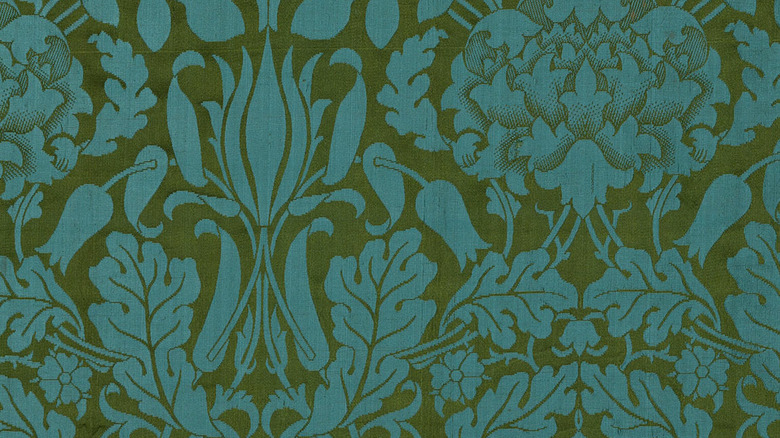The Truth About Deadly Victorian Wallpaper
As he lay in his deathbed, disgraced Victorian author and playwright Oscar Wilde said, "My wallpaper and I are fighting a duel to the death. One or the other of us has to go" (via The Guardian). Although the pithy passage was not meant by Wilde to imply that the wallpaper was actually plotting to kill him, Victorian wallpaper was known to be brightly colored with designs that were not to everyone's liking (Wilde included). Some people alive in the Victorian era, though, did experience mysterious health problems, and some even died as a result. In these cases, the culprit in question may have in fact been their wall coverings.
According to Smithsonian Magazine, bright green was a common color in the Victorian era for wallpaper, and the hue called Scheele's Green, developed by a Swedish chemist named Carl Sheele, was a particularly popular choice. Wall covering aside, Victorians couldn't get enough bright color in their lives, and similar chemical experiments were conducted to produce the brightest colors possible on all sorts of personal items, as The Washington Post reports. There was an emerging middle class at the time to which home decor manufacturers catered. But when one family in particular fell ill, questions were raised about whether these home decor products could be to blame.
Four children died from one family
A serious inquiry was mounted by one English medical doctor after treating an entire family who had mysteriously fallen sick, including four children who died. As part of that process, the doctor, Thomas Orton, used the process of elimination, suspecting that what might have stricken the family and killed the children could be environmental. The water supply was safe, Orton found out. Nor did he find anything else where the family was living that might be the root cause of the malady. Nothing, that is, save the particular shade of green wallpaper on the walls of their home, per Smithsonian Magazine.
The notion that certain wallpaper could actually kill people was nothing new, especially in continental Europe. So long as people weren't eating it, though, Victorians figured the wallpaper was safe. But could something in how the wallpaper was created — or even the dyes used to produce those colors — be sickening consumers all over the world? And what could possibly be so poisonous as to kill a person without even being ingested?
The wallpaper was made with arsenic
To produce the popular shade of color for Victorian wallpaper called Scheele's Green, Carl Sheele used copper arsenite to get the results he desired. The dangers of arsenic were well known at the time, but most figured — especially in Britain — that so long as nobody ate it, then the wallpaper was safe. But what Victorians failed to realize is that arsenic is toxic to breathe, and can even be dangerous when absorbed through the skin, as The Washington Post explains.
For this reason, a public awareness campaign was launched by Michigan physician Robert C. Kedzie and the Michigan State Board of Health, among others, and wallpaper manufacturing was changed. Not everyone, though, was convinced, including wallpaper designer William Morris (pictured), who also happened to be an heir to an arsenic manufacturer. He had arsenic wallpaper in his home, and he was fine. For this reason he wrote (via Smithsonian Magazine), "As to the arsenic scare a greater folly it is hardly possible to image." Turns out Morris was wrong, and dead wrong, and the arsenic wallpaper truly was at fault for the illnesses.


